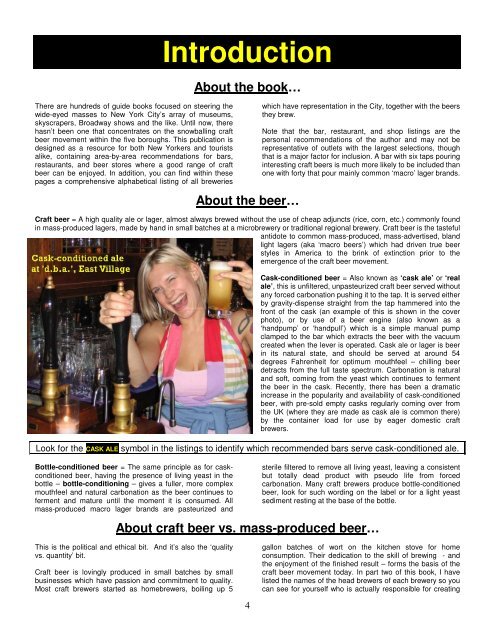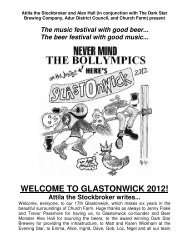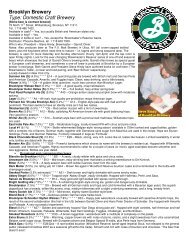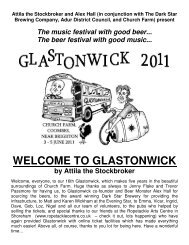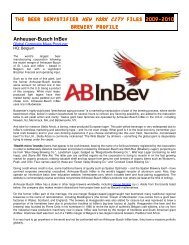beer demystifier - new york city - The Gotham Imbiber
beer demystifier - new york city - The Gotham Imbiber
beer demystifier - new york city - The Gotham Imbiber
You also want an ePaper? Increase the reach of your titles
YUMPU automatically turns print PDFs into web optimized ePapers that Google loves.
<strong>The</strong>re are hundreds of guide books focused on steering the<br />
wide-eyed masses to New York City’s array of museums,<br />
skyscrapers, Broadway shows and the like. Until now, there<br />
hasn’t been one that concentrates on the snowballing craft<br />
<strong>beer</strong> movement within the five boroughs. This publication is<br />
designed as a resource for both New Yorkers and tourists<br />
alike, containing area-by-area recommendations for bars,<br />
restaurants, and <strong>beer</strong> stores where a good range of craft<br />
<strong>beer</strong> can be enjoyed. In addition, you can find within these<br />
pages a comprehensive alphabetical listing of all breweries<br />
Introduction<br />
About the book…<br />
About the <strong>beer</strong>…<br />
4<br />
which have representation in the City, together with the <strong>beer</strong>s<br />
they brew.<br />
Note that the bar, restaurant, and shop listings are the<br />
personal recommendations of the author and may not be<br />
representative of outlets with the largest selections, though<br />
that is a major factor for inclusion. A bar with six taps pouring<br />
interesting craft <strong>beer</strong>s is much more likely to be included than<br />
one with forty that pour mainly common ‘macro’ lager brands.<br />
Craft <strong>beer</strong> = A high quality ale or lager, almost always brewed without the use of cheap adjuncts (rice, corn, etc.) commonly found<br />
in mass-produced lagers, made by hand in small batches at a microbrewery or traditional regional brewery. Craft <strong>beer</strong> is the tasteful<br />
antidote to common mass-produced, mass-advertised, bland<br />
light lagers (aka ‘macro <strong>beer</strong>s’) which had driven true <strong>beer</strong><br />
styles in America to the brink of extinction prior to the<br />
emergence of the craft <strong>beer</strong> movement.<br />
Cask-conditioned <strong>beer</strong> = Also known as ‘cask ale’ or ‘real<br />
ale’, this is unfiltered, unpasteurized craft <strong>beer</strong> served without<br />
any forced carbonation pushing it to the tap. It is served either<br />
by gravity-dispense straight from the tap hammered into the<br />
front of the cask (an example of this is shown in the cover<br />
photo), or by use of a <strong>beer</strong> engine (also known as a<br />
‘handpump’ or ‘handpull’) which is a simple manual pump<br />
clamped to the bar which extracts the <strong>beer</strong> with the vacuum<br />
created when the lever is operated. Cask ale or lager is <strong>beer</strong><br />
in its natural state, and should be served at around 54<br />
degrees Fahrenheit for optimum mouthfeel – chilling <strong>beer</strong><br />
detracts from the full taste spectrum. Carbonation is natural<br />
and soft, coming from the yeast which continues to ferment<br />
the <strong>beer</strong> in the cask. Recently, there has been a dramatic<br />
increase in the popularity and availability of cask-conditioned<br />
<strong>beer</strong>, with pre-sold empty casks regularly coming over from<br />
the UK (where they are made as cask ale is common there)<br />
by the container load for use by eager domestic craft<br />
brewers.<br />
Look for the CASK ALE symbol in the listings to identify which recommended bars serve cask-conditioned ale.<br />
Bottle-conditioned <strong>beer</strong> = <strong>The</strong> same principle as for caskconditioned<br />
<strong>beer</strong>, having the presence of living yeast in the<br />
bottle – bottle-conditioning – gives a fuller, more complex<br />
mouthfeel and natural carbonation as the <strong>beer</strong> continues to<br />
ferment and mature until the moment it is consumed. All<br />
mass-produced macro lager brands are pasteurized and<br />
sterile filtered to remove all living yeast, leaving a consistent<br />
but totally dead product with pseudo life from forced<br />
carbonation. Many craft brewers produce bottle-conditioned<br />
<strong>beer</strong>, look for such wording on the label or for a light yeast<br />
sediment resting at the base of the bottle.<br />
About craft <strong>beer</strong> vs. mass-produced <strong>beer</strong>…<br />
This is the political and ethical bit. And it’s also the ‘quality<br />
vs. quantity’ bit.<br />
Craft <strong>beer</strong> is lovingly produced in small batches by small<br />
businesses which have passion and commitment to quality.<br />
Most craft brewers started as homebrewers, boiling up 5<br />
gallon batches of wort on the kitchen stove for home<br />
consumption. <strong>The</strong>ir dedication to the skill of brewing - and<br />
the enjoyment of the finished result – forms the basis of the<br />
craft <strong>beer</strong> movement today. In part two of this book, I have<br />
listed the names of the head brewers of each brewery so you<br />
can see for yourself who is actually responsible for creating


